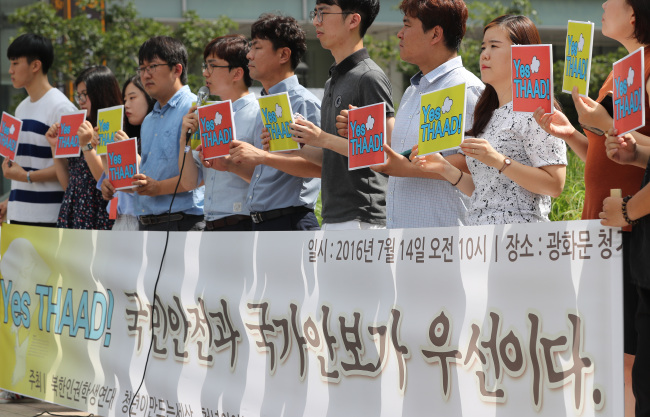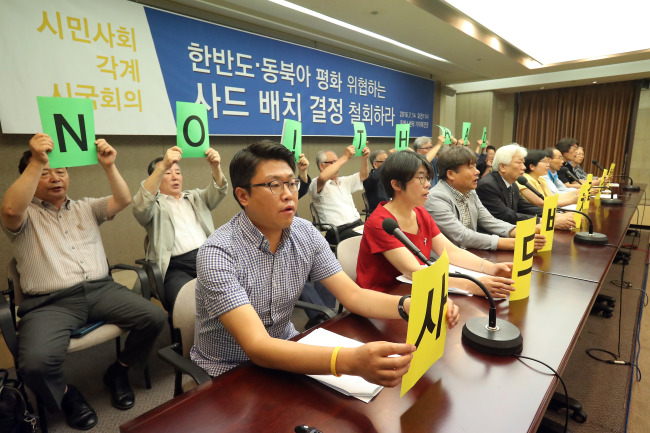The Defense Ministry on Thursday addressed ongoing rumors that the deployment of the Terminal High Altitude Area Defense system would pose a health threat, by publicly measuring the signals near other similar operational radars to show its limited impact.

Upon Wednesday’s announcement that THAAD will be deployed in Seongju-gun, North Gyeongsang Province, residents and county officials from the small town had fiercely protested the decision, with the county mayor and local councilors launching a hunger strike and locals holding mass rallies.

The allies’ decision to deploy THAAD as a protective measure against North Korea’s ballistic missiles last Friday had immediately stoked speculation about the candidate site. There has been widespread concern that the electromagnetic signal sent out by X-band radars -- microwaves similar to those sent out by mobile phones -- could be harmful to health and agriculture.
U.S. military’s THAAD base in Guam is located about 3 kilometers away from the nearest residential area, while one in Seongju will be around 1.5 kilometers from the nearest village.
In response to such concerns, the Defense Ministry unveiled the amount of electromagnetic exposure from the already-operational PAC-2 and Green Pine radars.
South Korea currently operates a launcher and a radar for the Patriot missiles at the Air Force base in the capital region, located at a closer distance from a residential area than the Seongju-based THAAD would be.
The Green Pine radar is operated in the country’s central region, and is 2-3 kilometers away from the nearest village.
Both the Patriot and Green Pine launch units are on mountains, at around 300 meters and 400 meters above sea level, respectively.
Military officials have asked not to disclose the exact location of the radars or the names of related personnel due to security issues.
The recommended safe distance from the PAC-2 radars -- when in operation -- is about 120 meters, which officials said is an indicator that it has a stronger impact on health compared to a THAAD radar, of which the recommended safe distance is 100 meters.
While the THAAD radar has a shorter safe distance, the output is known to be stronger. Officials said that the emission does not necessarily equal impact on health.
The military measured the electromagnetic wave exposure from a distance of 118 meters, 60 meters and 40 meters for six minutes each.
Officials said that both the International Commission on Non Ionizing Radiation Protection’s guidelines and the local law limits the exposure to electric and magnetic fields of high frequencies -- emitted by both THAAD’s radar and the radar for the patriot missiles -- to 10 watts per square meter over a period of six minutes. Exposure to waves exceeding this amount would lead to body-heat stress and excessive local tissue heating.
U.S. military’s THAAD base in Guam is located about 3 kilometers away from the nearest residential area, while one in Seongju will be around 1.5 kilometers from the nearest village.
In response to such concerns, the Defense Ministry unveiled the amount of electromagnetic exposure from the already-operational PAC-2 and Green Pine radars.
South Korea currently operates a launcher and a radar for the Patriot missiles at the Air Force base in the capital region, located at a closer distance from a residential area than the Seongju-based THAAD would be.
The Green Pine radar is operated in the country’s central region, and is 2-3 kilometers away from the nearest village.
Both the Patriot and Green Pine launch units are on mountains, at around 300 meters and 400 meters above sea level, respectively.
Military officials have asked not to disclose the exact location of the radars or the names of related personnel due to security issues.
The recommended safe distance from the PAC-2 radars -- when in operation -- is about 120 meters, which officials said is an indicator that it has a stronger impact on health compared to a THAAD radar, of which the recommended safe distance is 100 meters.
While the THAAD radar has a shorter safe distance, the output is known to be stronger. Officials said that the emission does not necessarily equal impact on health.
The military measured the electromagnetic wave exposure from a distance of 118 meters, 60 meters and 40 meters for six minutes each.
Officials said that both the International Commission on Non Ionizing Radiation Protection’s guidelines and the local law limits the exposure to electric and magnetic fields of high frequencies -- emitted by both THAAD’s radar and the radar for the patriot missiles -- to 10 watts per square meter over a period of six minutes. Exposure to waves exceeding this amount would lead to body-heat stress and excessive local tissue heating.

An official from the state-run Agency for Defense Development said repeated exposure to waves lower than the aforementioned standard would not be harmful to the human body, as it would not be enough to drive up body heat to do any damage.
Electromagnetic fields measured from a distance of 40 meters from the Patriot missile radars peaked at 0.2826 and averaged at 0.0735 watts per square meter.
Measured from 118 meters, the figures peaked at 0.0336 and averaged at 0.0065.
As lower-frequency signals travel further, the permitted amount of electromagnetic radiation for lower frequency Green Pine radar was 6 watts per square meter.
“Emission from the Green Pine is generally stronger than THAAD radar. At least its effect on health is evaluated to be greater,” explained a military official. The recommended safe distance for it is 530 meters.
The peak emission measured at 30 meters from the radar was 0.2658, while one measured at 100 meters peaked at 0.3228. The one further received more waves due to the lack of obstacles.
“I cannot definitively say that the same results would be applied for THAAD, but this shows a reasonable comparison as one radar is stronger than that of THAAD and another is weaker. And we can see that both are being operated safely in vicinity of a residential area,” said a military official.
Electromagnetic fields measured from a distance of 40 meters from the Patriot missile radars peaked at 0.2826 and averaged at 0.0735 watts per square meter.
Measured from 118 meters, the figures peaked at 0.0336 and averaged at 0.0065.
As lower-frequency signals travel further, the permitted amount of electromagnetic radiation for lower frequency Green Pine radar was 6 watts per square meter.
“Emission from the Green Pine is generally stronger than THAAD radar. At least its effect on health is evaluated to be greater,” explained a military official. The recommended safe distance for it is 530 meters.
The peak emission measured at 30 meters from the radar was 0.2658, while one measured at 100 meters peaked at 0.3228. The one further received more waves due to the lack of obstacles.
“I cannot definitively say that the same results would be applied for THAAD, but this shows a reasonable comparison as one radar is stronger than that of THAAD and another is weaker. And we can see that both are being operated safely in vicinity of a residential area,” said a military official.

He claimed that none of the soldiers, maintenance personnel or the residents near the base have suffered from health-related problems linked to the radars.
The Green Pine radar was installed late 2012, and has been operational since 2013. The Patriot launchers have been deployed for use since 2008.
The official added that various factors, including the location, the altitude, the angle the radars are pointed at and others will affect electromagnetic exposure. The amount of emission conventionally decreases in proportion to the distance, but as in case of Green Pine, the surrounding environment can be a factor as well.
But he pointed out that unlike the case of Patriot missile and Green Pine bases, a mountain stands in between the expected location of THAAD and the nearest county, indicating that any adverse effect on health would likely be lower.
South Korea and the U.S. military are slated to reveal the Guam THAAD base on Sunday to the Korean media for the first time, and Defense Minister Han Min-koo is expected to visit Seongju as early as next week to persuade residents on the system’s deployment.
By Yoon Min-sik (minsikyoon@heraldcorp.com)
The Green Pine radar was installed late 2012, and has been operational since 2013. The Patriot launchers have been deployed for use since 2008.
The official added that various factors, including the location, the altitude, the angle the radars are pointed at and others will affect electromagnetic exposure. The amount of emission conventionally decreases in proportion to the distance, but as in case of Green Pine, the surrounding environment can be a factor as well.
But he pointed out that unlike the case of Patriot missile and Green Pine bases, a mountain stands in between the expected location of THAAD and the nearest county, indicating that any adverse effect on health would likely be lower.
South Korea and the U.S. military are slated to reveal the Guam THAAD base on Sunday to the Korean media for the first time, and Defense Minister Han Min-koo is expected to visit Seongju as early as next week to persuade residents on the system’s deployment.
By Yoon Min-sik (minsikyoon@heraldcorp.com)



![[Herald Interview] 'Amid aging population, Korea to invite more young professionals from overseas'](http://res.heraldm.com/phpwas/restmb_idxmake.php?idx=644&simg=/content/image/2024/04/24/20240424050844_0.jpg&u=20240424200058)






![[Hello India] Hyundai Motor vows to boost 'clean mobility' in India](http://res.heraldm.com/phpwas/restmb_idxmake.php?idx=644&simg=/content/image/2024/04/25/20240425050672_0.jpg&u=)








